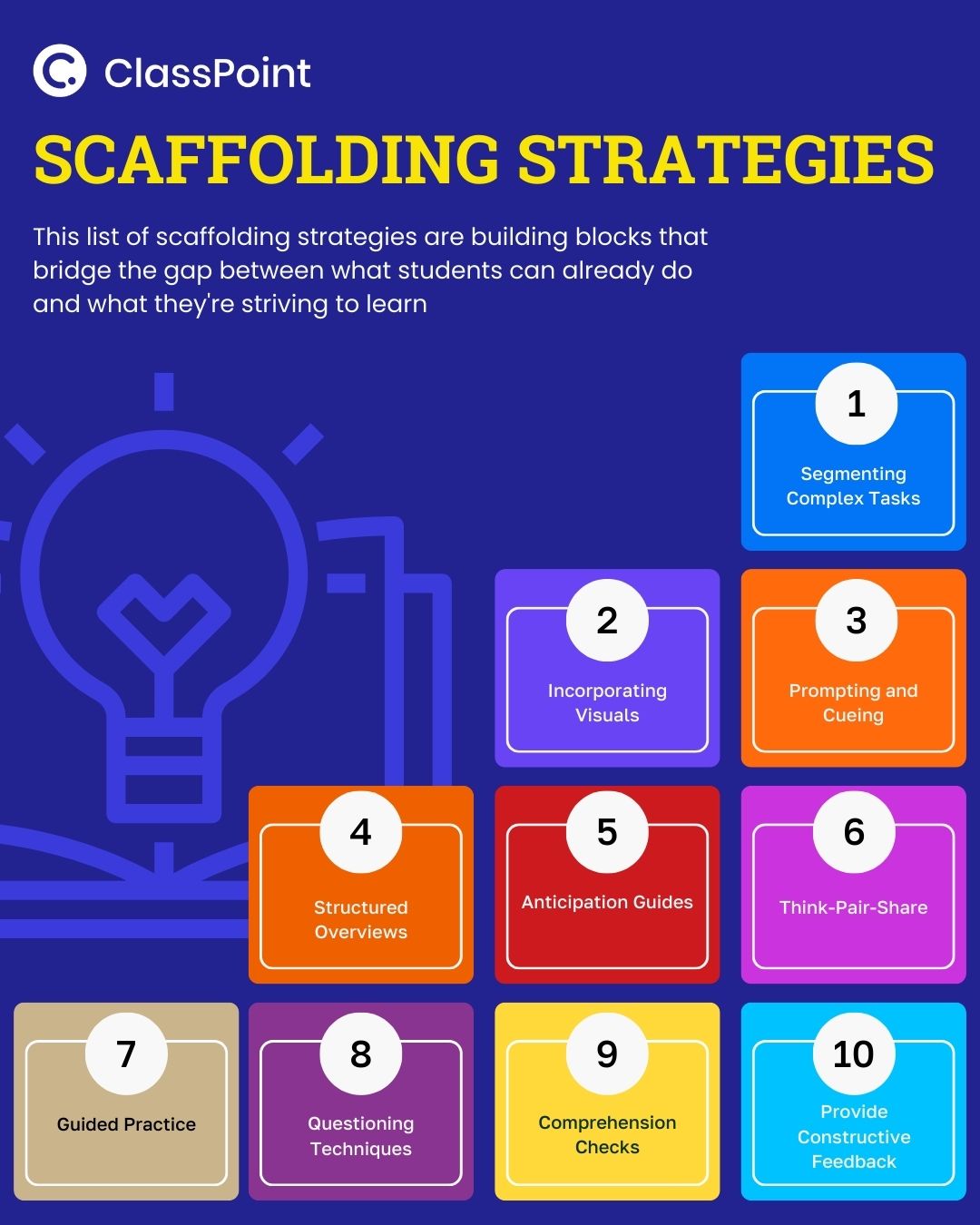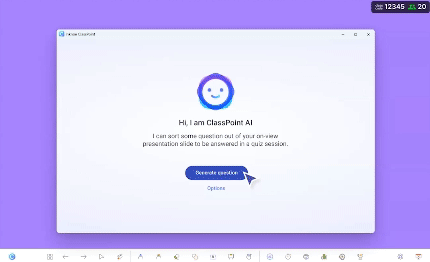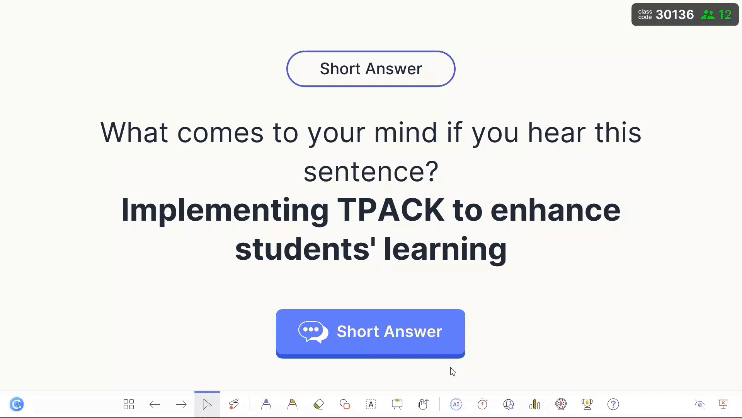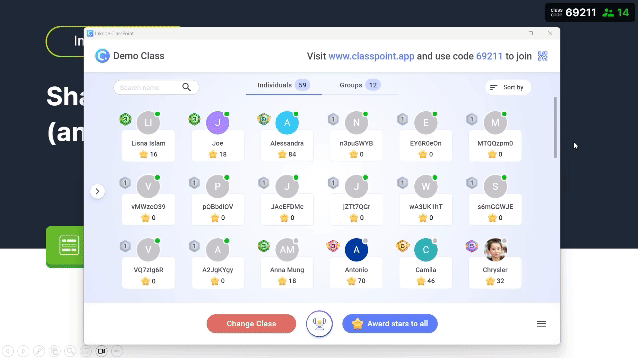10 Must-Try Scaffolding Strategies to Help Students Master Any Skill in the Modern Classroom
In today’s diverse classrooms, educators face the challenge of catering to a range of learning styles and abilities. Scaffolding strategies have become a vital tool for teachers to effectively support all students, as they grasp new concepts and develop essential skills. This comprehensive guide will equip you with practical strategies to create a supportive learning environment and empower your students to reach their full potential.
What are Scaffolding Strategies?
Scaffolding, in an educational context, refers to a set of temporary supports provided by teachers to help students learn new information or skills. Derived from the work of educational theorist Lev Vygotsky, it is a teaching method that involves breaking learning into manageable chunks and providing support structures to aid student understanding. It requires using a variety of instructional techniques to move students progressively toward stronger understanding and greater independence in the learning process. Like the temporary structures used in construction, scaffolding in teaching is gradually removed as students gain confidence and mastery.
Why is Scaffolding Important?
Scaffolding plays a crucial role in promoting student success. It allows students to approach complex tasks with confidence and a sense of accomplishment. It helps bridge learning gaps, promotes deeper understanding, and builds student confidence. Scaffolding also supports differentiated instruction and helps teachers meet diverse student needs, particularly in mixed-ability classrooms.
10 Key Scaffolding Teaching Strategies

Think of this list of scaffolding strategies as building blocks that bridge the gap between what students can already do and what they’re striving to learn. Here are some effective scaffolding techniques to incorporate into your teaching:
#1 Segmenting Complex Tasks
Breaking down challenging tasks into smaller, manageable segments is essential for effective scaffolding. This approach reduces cognitive load, allowing students to focus on one part at a time and build confidence incrementally. It prevents overwhelm and instills a sense of accomplishment with each completed step. Additionally, it helps students develop a systematic approach to complex tasks, a skill valuable beyond the classroom.
Example: Divide essay writing into brainstorming, outlining, drafting, and revising.
#2 Incorporating Visuals

Utilizing visual aids like charts, graphs, mind maps and images simplifies complex information and reinforces learning. Visuals break down abstract concepts into tangible forms, making them easier to understand. This strategy benefits visual learners and caters to diverse learning styles, providing multiple engagement avenues. Visual aids also serve as reference points, reinforcing learning and aiding retention, creating a more inclusive and dynamic learning environment.
Example: A timeline helps students grasp historical events chronologically, while a diagram clarifies the water cycle.
Pro Tip: Try incorporating multimedia and interactive elements while presenting and teaching to ensure optimised learning.
#3 Prompting and Cueing
Offer hints or prompts to guide students toward the correct answer. This involves giving subtle cues or asking leading questions that nudge students in the right direction without providing the answer directly. The aim is to develop their problem-solving skills and independence by gradually reducing the assistance given, and encouraging them to rely on their reasoning and understanding.
Example: If a student struggles with a math problem, you might remind them of a similar problem they have solved or suggest they review a specific step.
Pro Tips: Generate quiz questions from PowerPoint slides using ClassPoint AI and incorporate automatically-generated hints and cues provided by the AI.
#4 Structured Overviews
Provide summaries or outlines before teaching new content to give students a clear roadmap of what they will learn. A structured overview serves as a preview, highlighting main topics and key concepts, helping students organize their thoughts and set a learning purpose. This preview also connects new content to prior knowledge, helping students see the big picture.
Example: Before a unit on photosynthesis, outline the process, the role of chlorophyll, and the importance of sunlight.
#5 Anticipation Guides
Use pre-reading strategies to activate prior knowledge and generate interest in the topic. An anticipation guide includes statements related to the upcoming content. Students indicate whether they agree or disagree with these statements before engaging with the material. This stimulates curiosity and connects new information to prior knowledge.
Example: Before a lesson on ecosystems, have students agree or disagree with statements like “All plants and animals in an ecosystem are interdependent.”
Pro Tip: Use ClassPoint's Quick Poll to instantly gather opinions from students.

#6 Think-Pair-Share
Implement this strategy to encourage student interaction and idea sharing, promoting a collaborative learning environment. Think-Pair-Share involves three steps: students think about a question individually, discuss it with a partner, and share it with a larger group. This promotes active learning, allowing students to articulate their ideas and hear different perspectives.
Example: Students read a passage & identify text examples revealing a character’s personality traits. Discuss chosen examples & traits as a pair, then share with the class.
Pro Tip: Gather students at random using Name Picker or Grouping to maximise interactions in the classroom.
#7 Guided Practice
Provide opportunities for students to practice skills with your support before moving to independent work, ensuring they feel confident and prepared. During guided practice, the teacher works closely with students, offering immediate feedback and assistance. This phase bridges the gap between instruction and independent practice, building student confidence and competence.
Example: After teaching a new math concept, work through problems together as a class, gradually letting students take more responsibility.
#8 Questioning Techniques

Use open-ended questions to stimulate critical and higher-order thinking skills, encouraging students to explore and articulate their understanding. Open-ended questions require more than a yes or no answer, prompting students to explain their reasoning and make connections. This approach fosters deeper understanding, curiosity, and inquiry, motivating students to engage more actively in their learning.
Example: Instead of asking “Did you like the story?” ask, “What did you think about the protagonist’s decision to leave home, and why?”.
Pro Tip: Try these higher order Bloom's Taxonomy questions in class. To auto-generate Bloom's Taxonomy questions from your PowerPoint slides, try ClassPoint AI.
#9 Checking for Comprehension Along the Way
Regularly assess students’ understanding through formative assessments, interactive quizzes and check-in questions. By continuously monitoring comprehension, you can identify and address any misunderstandings promptly, ensuring that students are on track and ready to progress to the next segment of learning.
Example: Utilize quick quizzes, thumbs-up/thumbs-down responses, exit tickets, or one-on-one discussions.
Pro Tip: Here are 50 use cases on how you can conduct interactive quizzes in the classroom.
#10 Providing Constructive Feedback
Offer constructive feedback to students on their performance and progress. Feedback should be specific, actionable, and focused on areas for improvement, as well as highlighting strengths. Effective feedback encourages a growth mindset, encouraging students to see mistakes as opportunities for learning and growth rather than failures. It also reinforces the teacher-student partnership in the learning process, promoting a collaborative and supportive classroom environment.
Example: When giving feedback on a student’s essay, you could say, “Great use of strong verbs in your introduction. For the next draft, consider expanding on your main points with more evidence to strengthen your arguments.” Alternatively, an effective way to provide feedback is using gamification elements that all students love!
Consider implementing other classroom management and teaching styles with your scaffolding. This includes project-based learning, inquiry-based learning, the Harkness method, or the Socratic method.
Implementing Scaffolding Strategies in the Classroom
Scaffolding techniques are powerful tools, but just like any tool, their effectiveness depends on how you use them. Here’s a roadmap to guide you through a 3-step process of integrating scaffolding into your daily classroom routine:
First, Plan the Blueprint!

🔎 Identify Learning Gaps: Begin by pinpointing areas in your lesson plan where students might encounter challenges. Are there complex concepts, unfamiliar vocabulary terms, or multi-step procedures involved? Anticipating these hurdles allows you to strategically place scaffolding supports.
🔎 Match the Scaffold to the Need: Not all students require the same level of support. Consider individual student needs and learning styles when choosing appropriate scaffolding teaching strategies.
🔎 Variety is Key: Don’t rely on a single scaffolding technique throughout the lesson. Mix and match different strategies to keep students engaged and cater to diverse learning preferences.
Then, Build the Structure!
👉 Make it Clear: Clearly communicate learning objectives and expectations to students at the outset. This provides a roadmap for them to follow as they navigate the lesson with your scaffolding support.
👉 Model and Demonstrate: Before asking students to dive in, model the task or skill yourself. Think aloud as you complete the steps, providing students with valuable insights into your thought process.
👉 Break it Down: For complex tasks, provide students with a step-by-step breakdown. Consider using checklists, graphic organizers, or visual aids to break down the process into manageable chunks.

👉 Practice Makes Progress: Offer guided practice opportunities where students can work on the task with your support. Utilize timers to manage the flow of this activity, especially during group work or independent practice. Consider incorporating interactive quizzes or activities to check for understanding throughout this phase.
👉 Differentiation Through Groups: Students learn at different paces and have varying needs. Create mixed-ability groups for collaborative activities to allow peer support, with stronger students explaining concepts and everyone contributing their strengths.
Finally, Monitor and Adjust!
💡Check for Understanding: Regularly assess student comprehension throughout the lesson. This can be done through questioning techniques, exit tickets, quick polls, or short formative assessments.
💡 Adapt and Adjust: Based on student responses, be prepared to adjust your scaffolding strategies on the fly. If students seem overwhelmed, provide additional support. If they grasp the concept quickly, you can gradually decrease the level of scaffolding.

💡Celebrate Success: Acknowledge and celebrate student progress as they master skills with decreasing levels of scaffolding through positive reinforcements like awarding stars, praises, and so on. This motivates students and reinforces their confidence as independent learners.
Final Thoughts
Incorporating scaffolding strategies is essential for meeting the diverse learning needs in today’s classrooms. These techniques provide the support students need to tackle complex tasks and gain independence in learning. By breaking down tasks, using visual aids, offering prompts, and providing structured overviews, teachers create a dynamic and inclusive environment that supports curious learners
Thoughtful implementation of these scaffolding techniques not only bridges learning gaps but also empowers students to become confident, independent learners, helping them reach their full potential. As you observe your students’ progress, refine your approach and celebrate their successes along the way. Embrace scaffolding as a powerful tool to unlock student potential and inspire a love of lifelong learning in your classroom.
Comments
Post a Comment